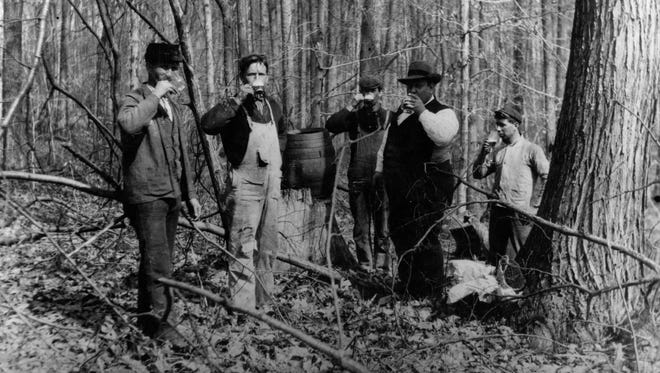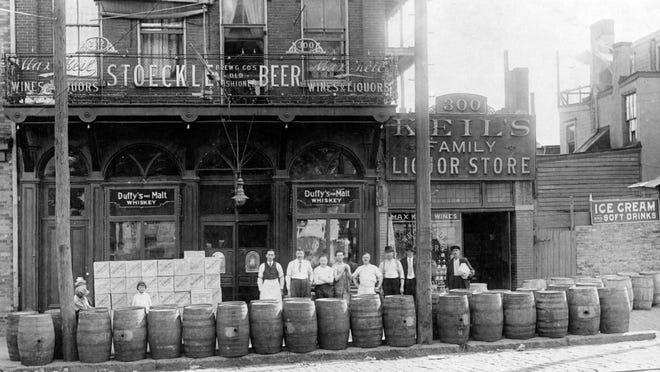10 Delaware beer facts you need to know


Did you know that when you drive through Wilmington on I-95 that you're driving over the exact spot where the Diamond State Brewery once stood – the final of the major First State breweries to fall post-Prohibition?
And when you're sharing a pizza with friends at Gallucio's Italian Restaurant, do you know that you're surrounded by Delaware beer history?
The building dates back to 1865 when it was built as a hotel and saloon by brewers John Fehrenbach and John Hartmann, a year before the sprawling Hartmann & Fehrenbach Brewery was built behind it along Brandywine Creek.
Or what about The Columbus Inn across town?
It started as a bakery in the late 1790s and was converted to a tavern as early as 1812. It remains one of Delaware's oldest, still-operating barrooms along with Kelly's Logan House in Wilmington, The Deer Park Tavern in Newark and The Brick Hotel in Georgetown.
The new 127-page book "Brewing in Delaware" ($21.99, Arcadia Publishing) by Delaware beer historian John Medkeff Jr. gives a guided tour of Delaware's sudsy beer history from the state's earliest settler to today's Delaware brewers led by Sam Calagione of Dogfish Head.
Medkeff, a Wilmington native, spent 20 years gathering more than 200 vintage brewing-in-Delaware images that fill the book, while meticulously putting the modern day craft beer boom in context of the area's more than 375-year history of beer brewing.
To celebrate Delaware's beer history, Medkeff will host "Delaware: A Brew Story" at Blue Ball Barn at Alapocas Run State Park on Sept. 5. He will lead a discussion and about 15 Delaware breweries will give samples. Wilmington duo Hot Breakfast! will perform. Tickets are $25.
We raided Medkeff's book for 10 Delaware beer facts that should strike the fancy of 302 area code beer drinkers. We chatted with Medkeff over a beer at Iron Hill Brewery & Restaurant in Wilmington earlier this week.
So pour a beer, put your feet up and swim into Delaware's rich brewing past.
1. Even before Prohibition, there was a strong anti-bar movement led by the Anti-Saloon League, founded nationally in the late 1800s. The group had campaigns targeting individual states to banish barrooms. In Delaware, it even included a song called "No Saloon in Delaware" in the early 1900s. Here's the chorus of the catchy number: "Oh, our Delaware! Our beloved Delaware!/For a stainless flag is waving in beloved Delaware/Oh our Delaware! Our beloved Delaware!/Here's the loyal son that pledges/No Saloon in Delaware." About 80 years later, the state's best-known rocker, George Thorogood, would write "I Drink Alone" with the lyrics, "Every morning just before breakfast/I don't want no coffee or tea/Just me and good buddy Wiser/That's all I ever need." I guess we know which side won.

2. Brewing beer was one of the first occupations of Delaware's Swedish settlers dating back to the late 1600s at Fort Christina. Since many associated water to sickness due to polluted water in Europe, settlers sustained themselves by growing grains for both baking and beer. "They knew that if they drank beer, they wouldn't get sick," Medkeff says. (They also knew it gave them a pretty good buzz.)
3. After Diamond State Brewing closed in 1955 at Fifth and Adams streets, there was no beer legally brewed in the state until Rockford Brewing Company opened for business on June 1, 1995. Later that same month, Calagione's Dogfish sprouted and state law was changed to allow brewpubs.
4. Rushing the growler. Sure, the new growler stations popping up across the state are a handy way to get personal portions of draft beer home or to a picnic, but its not too far off from the way workers would get their beer. "Growlers back in the day were tin pails," Medkeff says. "You would pay a kid 5 cents to go down to the saloon to fill up your growler." "Rushing the growler" was a term used back then to describe the trip back and forth with the pail. There's much debate about the origins of the term "growler," however.
5. Ever wonder why breweries have to sell their beer to distributors in Delaware, who then sell it to retailers? The three-tiered system was created post-Prohibition to avoid breweries from becoming too big and powerful. Before Prohibition, Wilmington's "Big Three" breweries – Hartmann & Fehrenbach, Stoeckle and Bavarian – controlled everything from production to distribution with major stakes in the hotels and saloons that sold their beers. Who is the man who installed the new system that remains today? Pierre S. du Pont, former head of DuPont and General Motors who was the head of the state's newly-established liquor commission at the time. Bonus fact: The "Big Three," which were all family-owned, controlled an estimated 98 percent of the beer market in Wilmington from 1880-1920, Medkeff says, with locals exclusively drinking those local brews at that time.

6. German-born John Fehrenbach of the Hartmann & Fehrenbach Brewery was 21 when he arrived in Delaware. Not only did he found one of the state's largest-ever breweries, but he helped found something else that lives on to today. (And, yes, it involves beer.) He was behind a singing society that would become the Delaware Saengerbund – the same spot that still hosts Oktoberfest each year in Ogletown. Prost!
7. It was almost Miller Time in Delaware back in 1970. The then-Miller Brewing Company purchased a plot of land near Newark on Del. 72 between Old Baltimore Pike and Chestnut Hill Road with intentions of opening a large production facility to service the East Coast. The plan was scuttled when Philip Morris, now Altria, purchased Miller around the same time of the purchase.

8. While the vast majority of Delaware beer brewers are men today, that wasn't always the case. Before the production breweries came to town, most brewing was done in the late 1600s and early 1700s in homes and at taverns in the countryside. And that duty fell to women since it was considered a household chore like baking and laundry.
9. The Newark, N.J.-based Gottfried Krueger Brewing Company, which brewed Krueger beer, revolutionized the industry in 1935 when it became the first company to can beer, two years after the death of Prohibition. In 1944, Kruger bought a brewery from the Delmarva Brewing Company at Fifth and DuPont streets in Wilmington where it both canned and bottled beers for its more southern market, which stretched from Delaware to West Virginia. The brewery closed in 1950.

10. An 11-foot, Brooklyn-made Gambrinus zinc statue stood over Fifth Street in Wilmington from an alcove on the hulking Diamond State Brewery. After the brewery was demolished to make way for I-95, the statue stood in front of the old Cohen Brothers Furniture on Madison Street at what is now the Riverfront. Later, it found a home in front of The King's Inn (now Harry's Savoy Grill) in Brandywine Hundred until the early '70s. So what's the latest news on Gambrinus, the mythical European beer hero turned beer-in-Delaware icon? The bad news is that the statue was dropped while being moved in 1978, breaking into dozens of pieces. The good news? Medkeff tracked down the statue a couple of years ago at the former Browntown home of Dr. John A. Brown, for whom the neighborhood is named. The statue's owner had recently passed away and Medkeff was given the statue by the owner's estate since it was headed for the trash heap. Medkeff and others will soon launch a campaign to raise funds to restore the statue, which still has its head intact. Plans are to donate The King to the Delaware Historical Society after restoration.
IF YOU GO
What: "Delaware: A Brew Story"
Details:John Medkeff Jr. discusses Delaware beer history with about 15 Delaware breweries on hand with samples. Hot Breakfast! will perform and WiLDWiCH food truck will be offering free snacks. The event benefits Friends of Historic Riverview Cemetery and Wilmington State Parks' School Programs Scholarship Fund.
When: Sept. 5, 5-10 p.m.
Where: Blue Ball Barn at Alapocas Run State Park, 1914 W. Park Dr., near Wilmington
Cost: $25
Tickets and information: delaware-a-brew-story.eventbrite.com
-- Ryan Cormier, The News Journal. Facebook: @ryancormier. Twitter: @ryancormier. Instagram: @ryancormier.